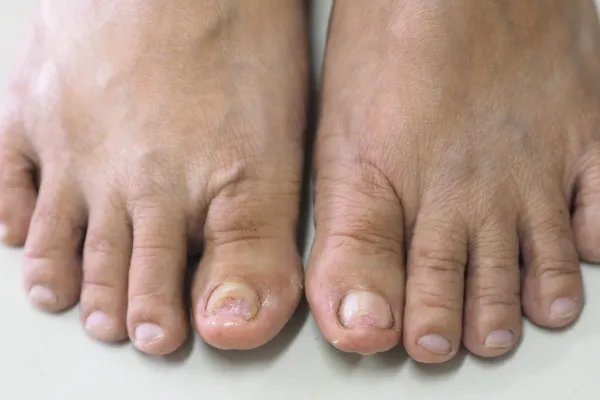Tips & Advice From Foot & Ankle Associates of Southern NH

Fungal Toenail Infections Explained: Understanding Onychomycosis
Fungal toenail infections, medically known as onychomycosis, are a common yet often misunderstood condition affecting many people. At Foot & Ankle Associates of Southern NH, we believe that understanding this condition is the first step in effectively managing and preventing further nail damage. In this post, we’ll explore what onychomycosis is, discuss its causes, outline common symptoms, and present various treatment and prevention options.
What is Onychomycosis?
Onychomycosis is an infection of the nail caused by various types of fungi. This infection most commonly affects toenails, though it can also occur in fingernails. The fungi responsible for this condition thrive in warm, damp environments, which is why communal showers, pools, and even sweaty footwear contribute to an increased risk of developing fungal toenail infections.
Causes and Risk Factors
Multiple factors can predispose someone to developing onychomycosis:
Environmental Exposure: Frequent visits to communal areas and wearing tight, non-breathable footwear create an ideal environment for fungi.
Age: As we get older, the likelihood of developing nail infections increases due to reduced nail growth and diminished circulation.
Pre-existing Health Conditions: Conditions like diabetes or immune system issues can make it harder for the body to fight off fungal infections.
Trauma to the Nail: Minor injuries that damage the nail can provide an entry point for fungal organisms.
Understanding these risk factors can help you identify areas in your daily routine where simple adjustments might reduce the risk of infection.
Common Symptoms and Signs
Recognizing the signs of onychomycosis is crucial, as early detection often leads to a more straightforward treatment process. Here are some common symptoms:
Discoloration: The nail may turn yellow, brown, or even white as the infection progresses.
Thickening of the Nail: Fungal infections can cause the nail to become noticeably thicker, making it difficult to trim.
Brittleness or Crumbling: The nail’s texture might change, becoming brittle and crumbling at the edges.
Distortion: In more advanced cases, the nail may become misshapen or lift away from the nail bed.
Unpleasant Odor: Some infections produce a mild odor due to the fungal growth, which can also be a sign of onychomycosis.
If you notice these symptoms, it’s important to consider seeking advice to confirm whether it’s a fungal infection and to discuss treatment options.
Treatment Options
Treating onychomycosis can be a multifaceted approach, often requiring patience and persistence. Here are some effective treatment methods:
Topical Treatments: Over-the-counter antifungal creams and lacquers are often the first line of defense. They’re most effective for mild cases and require regular application over several months.
Oral Medications: In cases where topical treatments prove ineffective, oral antifungal drugs can be prescribed. While these medications may have more side effects, they often offer better results for more severe infections.
Laser Therapy: An increasingly popular option, laser therapy uses focused light waves to target and destroy the fungus without damaging the surrounding tissues.
Nail Debridement: Sometimes, removing part or all of the infected nail (nail debridement) is recommended to allow a healthier nail to grow in its place.
Combination Treatments: Often, the best results come from a combination of these therapies, along with proper foot hygiene and care.
Prevention and Long-Term Management
Preventing future fungal infections involves adopting a few simple habits:
Keep Feet Clean and Dry: Fungi thrive in moist environments, so regular washing and thorough drying, especially between the toes, is essential.
Wear Breathable Footwear: Choose shoes made from natural materials that allow your feet to breathe. Avoid tight shoes that trap moisture.
Use Antifungal Powders or Sprays: These products help maintain a dry environment and can be especially useful if you frequently use communal showers or pool facilities.
Regular Nail Care: Keeping your nails trimmed and clean helps prevent the accumulation of debris that fungi could use as a foothold.
Final Thoughts
Onychomycosis might seem like a minor inconvenience at first, but left unchecked, it can lead to painful, debilitating nail damage that affects your overall quality of life. Understanding the causes, recognizing the early signs, and acting promptly with the right treatment can make all the difference. Here at Foot & Ankle Associates of Southern NH, we are dedicated to providing thorough care and expert advice to help manage and prevent fungal toenail infections, ensuring that you maintain healthy nails and active, comfortable lives.
If you notice any signs of a fungal infection or have questions about maintaining nail health, don't hesitate to get in touch. Remember, early intervention is key, and a proactive approach can keep your nails strong and infection-free
Ask Foot & Ankle Associates of Southern NH And Their Team
Fill in the form to request a call from our team. One of our team members will call you for FREE and answer any questions or concerns you may have about your condition
Where To Find Foot & Ankle Associates of Southern NH

If you have any questions before scheduling an appointment or for general inquiries, please use the contact us button below. Our team will promptly reach out to assist you.
Opening Hours
Monday: 8:00am – 5:00pm
Tuesday: 8:00am – 5:00pm
Wednesday: 8:00am – 2:00pm
Thursday: 8:00am – 5:00pm
Friday: 8:00am – 2:00pm
Saturday: Closed
Sunday: Closed

